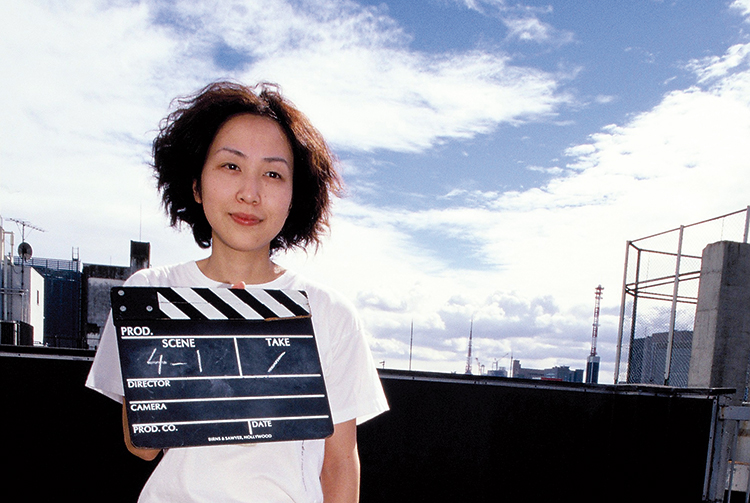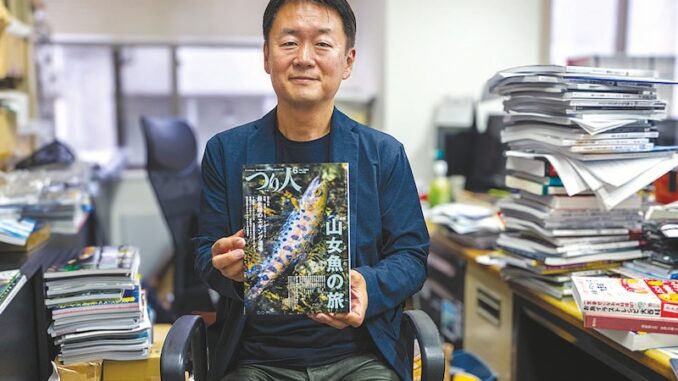
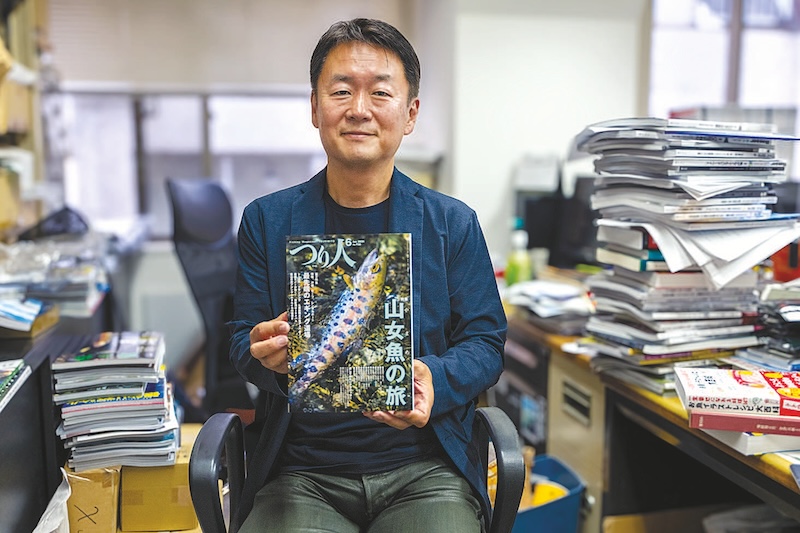
Founded nearly 80 years ago, the monthly magazine remains the standard reference for anglers and maintains its unique approach.
To get an idea of fishing’s popularity in Japan you only have to take a look at the amount of media devoted to this activity. On the internet, for instance, I found no less than 30 magazines, including monthlies, bimonthlies and quarterlies, and there is also a fishing-only broadcasting station, Tsuri Vision, a video streaming service delivering over 500 original programmes a year, 24 hours a day, 365 days a year.
The doyen of the fishing press is Tsuribito (Fisherman), a publication that has been around for almost 80 years. Publisher Tsurijinsha puts out four other magazines – Basser (bass fishing), North Angler’s (devoted to Hokkaido), FlyFisher and Masu no mori (trout fishing) – but Tsuribito, with a circulation of 20,000, is Japan’s most popular publication.
I talked to president and CEO Yamane Kazuaki about the magazine’s history and the evolution of the fishing scene in Japan). Yamane joined Tsurijinsha in 1994 and in 2006 became Tsuribito’s editor-in-chief. He enjoys fishing in all seasons, from mountain streams to rock and offshore fishing.
What is Tsuribito’s typical content?
You could call Tsuribito a magazine for fishing geeks. We provide content that you won’t find on the internet, such as good fishing spots and reports on different places around Japan. A good part of the magazine is devoted to seasonal fishing. For example, we cover mountain streams in spring and freshwater fish in summer, crucian carp in autumn and tanago in winter. Recently, we have done yamame and ayu.
This is a general interest magazine, but its content is quite specialized, so 90% of our readership is made up of men in their 40s to 60s, and most of them are mid-level to advanced anglers. In the past, we used to include articles for beginners, but since the advent of the internet, they can easily find a lot of free information online. On the other hand, you never know how much you can trust the information you find on the internet, so our readers are dedicated anglers who are willing to pay to get reliable articles from a specialized magazine with a long history.
Speaking of history, how was Tsuribito born, and what is your mission?
The magazine was launched in 1946, soon after the end of the war. As you know, Tokyo and all the other major cities had been reduced to rubble by the US air raids. Everyone was worried about the American occupation and the future of the country. A lot of people had lost everything and had almost nothing to eat. Needless to say, hardly any paper was left to make school textbooks. However, essayist and fishing journalist Sato Koseki realized that at a time when the Japanese were hurting both physically and mentally, fishing was probably the best thing they could do to cope with that tragedy. Japan may have lost the war, but there was no point in dwelling on it forever. And Sato believed that through fishing you could regain some peace of mind. When you go fishing, you stare at the water’s surface and forget everything. It’s like Zen meditation.
Sato knew many writers and artists and convinced them to contribute to the magazine. An essay by the great Ibuse Masuji, for example, was featured in the debut issue while the first covers were designed by such famous artists as Leonard Fujita and Kishinami Hyakusokyo, who painted the ceiling of Eiheiji, Japan’s main Zen temple. Later, manga artist Yaguchi Takao submitted a few ideas to the magazine. That was actually a two-way collaboration because Yaguchi, who was from Akita Prefecture, knew a lot about rivers, but he didn’t know much about sea fishing, so he got inspiration and advice from us for some of his stories.
Even today, I think that fishing is a symbol of peace. It’s not by chance that Tsuribito’s debut issue has a page with two photos juxtaposed: a big and muscular American soldier and a skinny Japanese child. One belongs to the winning side, the other to the losers, but they both look happy and smiling because they are fishing. I like to say that a country where a lot of people fish is peaceful.
You may know Izaak Walton, the English writer who published The Compleat Angler in 1653. England then was in the midst of the Puritan Revolution and the Civil War. Yet, Walton wrote a book about fishing, and the last sentence in that book reads, “Study to be quiet.” I think what he means is, stop fighting and go fishing; let’s be peaceful.
Even now, science is evolving at an incredible speed with things like AI, and people are quite worried about what will happen to humanity in the future, but when you go fishing you realize that we humans are just one animal species, just like fish, birds and raccoons. It makes you realize that humans are not really special.
A lot of new technology has appeared recently, and fishing has probably become easier than it was in the past. What do you think about the relationship between fishing and technology?
First of all, it must be said that people who fish have a high affinity for technology. What most people don’t know, for example, is that fishing boat captains were the first to use mobile phones to exchange emails. For them, wireless communication is important to keep in touch with each other and share information about the weather, sea conditions, etc. So, they were the first to get their hands on mobile phones when they appeared.
Technology is mainly hurting commercial fishing because of the huge nets they use and the way they catch all those fish. However, as long as anglers use a rod – even the most technologically advanced – the fish won’t disappear because we can only catch them one at a time.
The other important thing to remember is that successful fishing is not so much about technology. You need to know everything about the fish, such as where and when to catch them. You can’t catch fish unless you understand them and know their natural habitat. But nature is something that is beyond our understanding, so it often happens that one day I catch a lot of fish and then the next time I try in the same place and I can’t catch anything at all, even with the most advanced gear and all the information I can get instantly on the internet.
It never goes as expected. There’s also an element of chance. That’s what makes fishing interesting. If I was successful every time it would become boring.
Tsuribito is almost 80 years old. How has the fishing magazine market evolved in all these years?
Hobby fishing was originally based on freshwater fishing, while sea fishing was more a commercial activity. One reason for that was that saltwater fish are bigger comparatively. However, in those days, anglers used bamboo rods without a reel, which made catching big fish in the sea very hard. In other words, the gear available at the time was made for freshwater fishing. So, if you look at Tsuribito’s back issues, it’s all about fishing in rivers and lakes.
Then things began to change, sea fishing became popular, makers of fishing tackle came up with better gear, and fishing magazines followed those new trends. Now, for example, sea fishing with lures has become popular, and we cover that a lot.
Also, fish that can be caught near to where people are attract more attention now. For example, even in the city, on the waterfront, you can catch black sea bream in the river right below the buildings. Shrimp fishing is popular on Tokyo rivers in urban areas such as the Arakawa, Edogawa and Tama rivers from the rainy season to the summer, and many families line up along their banks during the holidays. There are so many fish you can catch now that probably the major change in the publishing world is that more and more specialized magazines have appeared and the market has become subdivided.
Also, as visual culture has become increasingly important, we have been releasing DVDs for some time and even have our own YouTube channel. In the past, taking pictures and videos underwater was a specialist skill and it would not have been possible for someone without a diving license and an expensive underwater camera. But now there are action cams like GoPro. Anyone can now take underwater photos by following the movement of the lure. In addition, we’ve already purchased and are operating an underwater drone. By making good use of new tools, even our editorial staff can now produce what used to be a specialist kind of photography. On the other hand, some people complain that underwater videos are taking away part of the fun of fishing because they reveal details that the angler could only imagine before. Some anglers say that some things should be left to the world of the imagination.
The other noteworthy change in magazine content is that, unfortunately, many fish that used to be popular have disappeared, not because of overfishing but because of urban development. They disappeared because many rivers were filled in and roads and apartment buildings appeared everywhere.
A typical example is the story of the crucian carp. According to an old Japanese proverb, fishing starts with crucian carp and ends with crucian carp. The reason is that in the past there were many rice fields just a short distance from our houses, and children would play there. Streams were flowing beside those rice fields and a lot of crucian carp could be found there, so children would catch them. Then when we grew up, we would target bigger fish, like carp, or go to the sea, but when we got older, we would go back to those rice fields and catch crucian carp again. Unfortunately, we can’t catch them anymore, at least not in Tokyo.
Did you also fish for crucian carp?
Yes. I grew up in Tokyo, and by that time crucian carp were nowhere to be found in my area, but my mother was from Yanagawa in Fukuoka Prefecture, and a lot of crucian carp could be caught around my grandparents’ house. Whenever we went there during the summer holidays my grandfather would take me fishing. He taught me how to catch them.
For one year after the earthquake in Tohoku, Tsuribito ran a series called “A Ray of Hope in the Darkness”. Why did you decide to do this series?
I was the editor-in-chief at the time. I was reminded of how the magazine had come into being and I felt that post-disaster Japan, and Tohoku in particular, resembled the country after the war. Everyone’s houses had been washed away and many people couldn’t work. In a sense, there was no point in worrying about what to do in the future because they had no control over their lives. So many people decided to go fishing. I had quite a few friends in Tohoku, and when I went there and listened to their stories, they told me about all the fish they were catching and how fishing saved their lives. Otherwise they’d all go crazy.
Some people may be reluctant to go fishing during an unprecedented event like that, and in truth, some people were rebuked by local residents for enjoying themselves in such circumstances. However, many people regained their peace of mind by experiencing fishing’s healing power. Then, about five years ago, there was another big earthquake in Kumamoto. I went there right away, and it was exactly the same. A lot of people took up fishing.
It seems that fishing magazines care a lot about the environment.
It couldn’t be otherwise. When I was a university student, I went to Hokkaido for about a month with a tent. Hokkaido is famous for its nature, and I was sure I’d be able to catch a lot of fish, like rainbow trout and brown trout. However, I had a hard time and I couldn’t understand why I couldn’t catch anything, so I went up the river. I heard a noise that sounded like a waterfall. Most river fish go upriver and when they find a waterfall, they gather under it. So, I thought I could finally catch some, but when I reached the place, I found out it wasn’t a waterfall but a dam. Why on earth would someone build a dam in such a place?! It’s just a waste of money, a common way in Japan to give work to the construction industry. And those dams are everywhere now. That’s why there are no fish.
So I thought, wait a second, if this ridiculous environmental destruction continues the fish will disappear. There’s nothing sadder than knowing the joy of fishing and then not being able to fish anymore. I decided that I had to do something to let people know what we were doing to nature. That’s why, when it was time to look for a job, I went into fishing media, starting as a part-timer and then becoming part of the editorial team.
I was really angry at that time. There are quite a lot of wasteful ways of spending money like that in Japan. It’s unforgivable. In the United States, water supply from dams has already reached its limit. The government has acknowledged it and has begun to dismantle many of them. And you know what? Once the dams are gone, soon the fish will come back. It’s a proven fact. Japanese officials know this, but they don’t do anything about it. They can’t do it. Because if you destroy a dam built by your boss before you, you’re not going to get promoted in Japan. So, everyone turns a blind eye to it, and there are plenty of useless dams in places where they’re no longer needed.
Fishing magazines, and Tsuribito in particular, take environmental education seriously. There’s an increasing number of prohibited fishing locations due to the bad behaviour of some of the anglers such as littering and fishing in prohibited areas. In order to prevent such a situation, we’re working to educate people about fishing etiquette not only through the magazine but also by making videos, which we show on our YouTube channel.
Why do you love fishing so much?
Let me answer with an old Chinese proverb: if you want to be happy for one hour, drink alcohol; if you want to be happy for three days, get married; if you want to be happy for eight days, kill a pig and eat it; if you want to be happy forever, learn to fish.
Interview by Gianni Simone
To learn more about this topic, check out our other articles :
N°142 [FOCUS] The Japanese, mad about fishing
N°142 [SEA] An all-consuming passion
N°142 [TOKYO] With the city-centre anglers
Follow us !

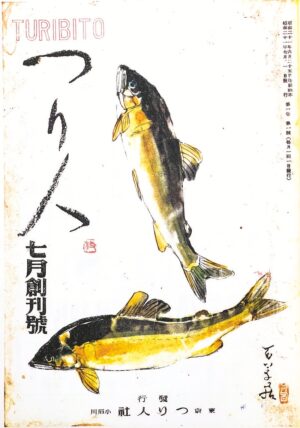
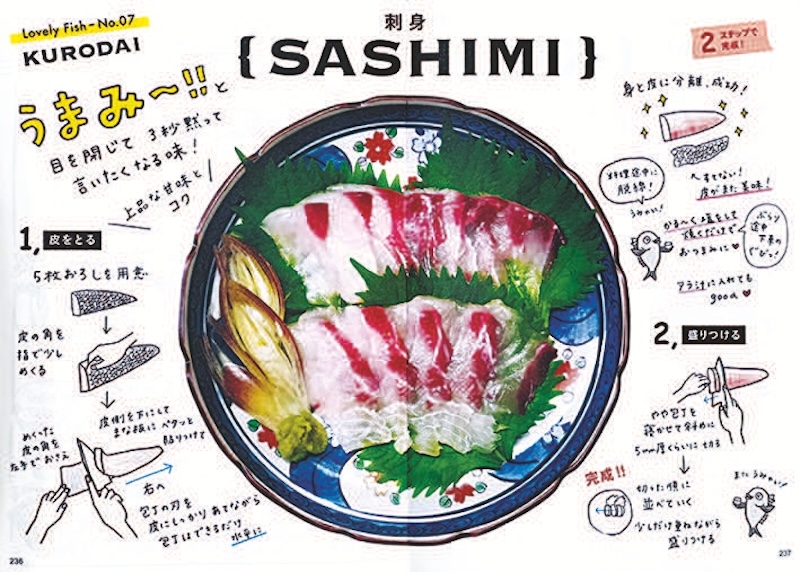
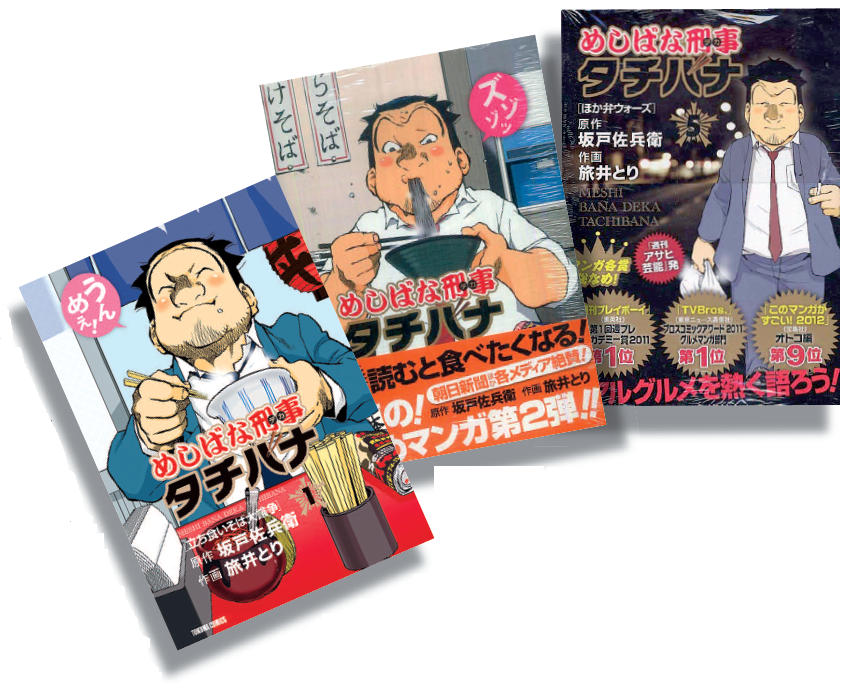
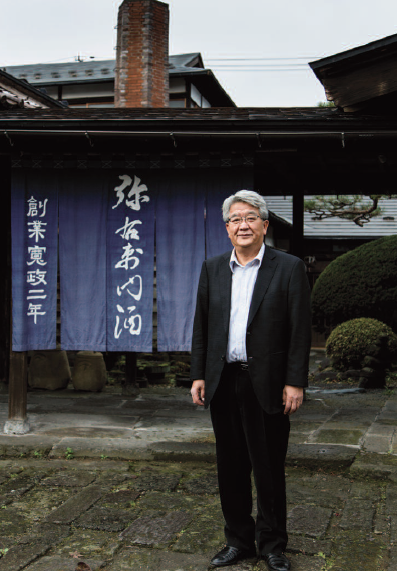
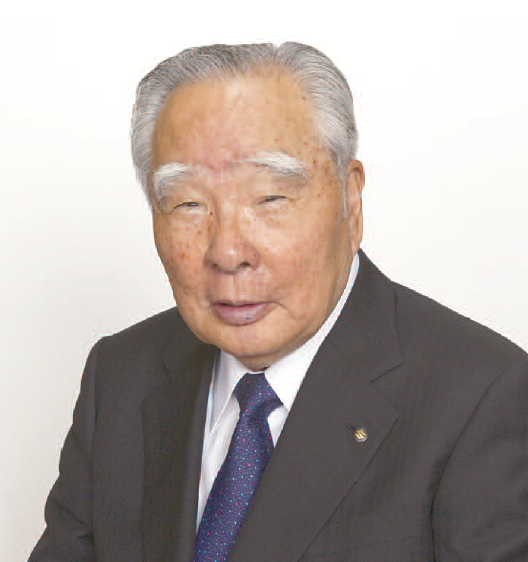

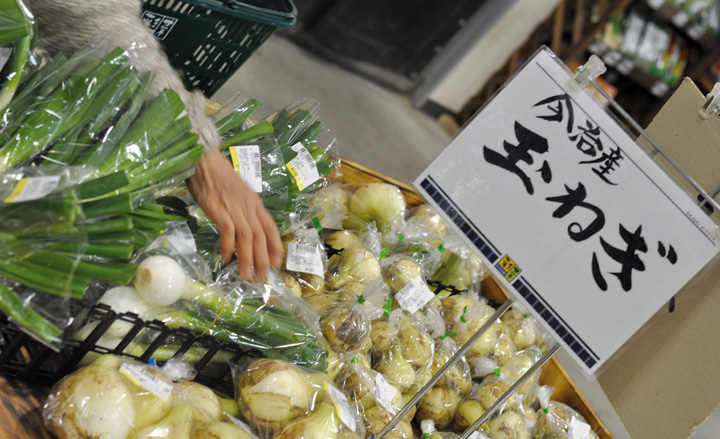
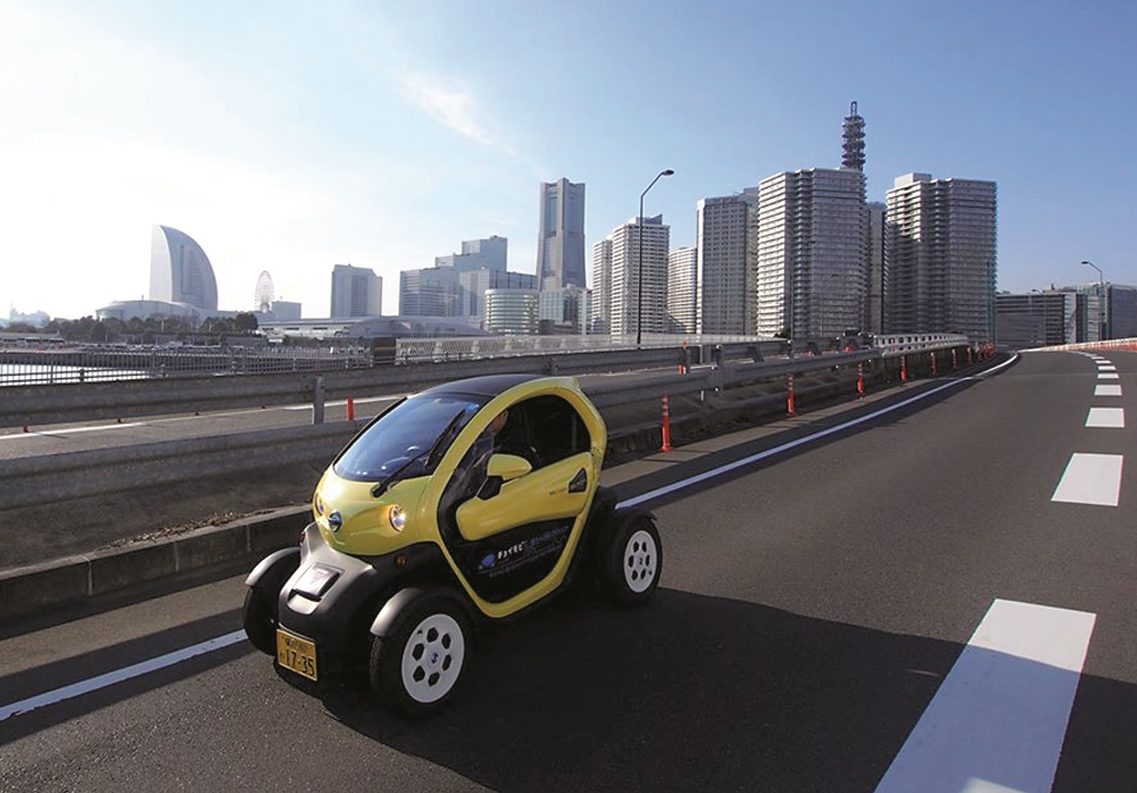
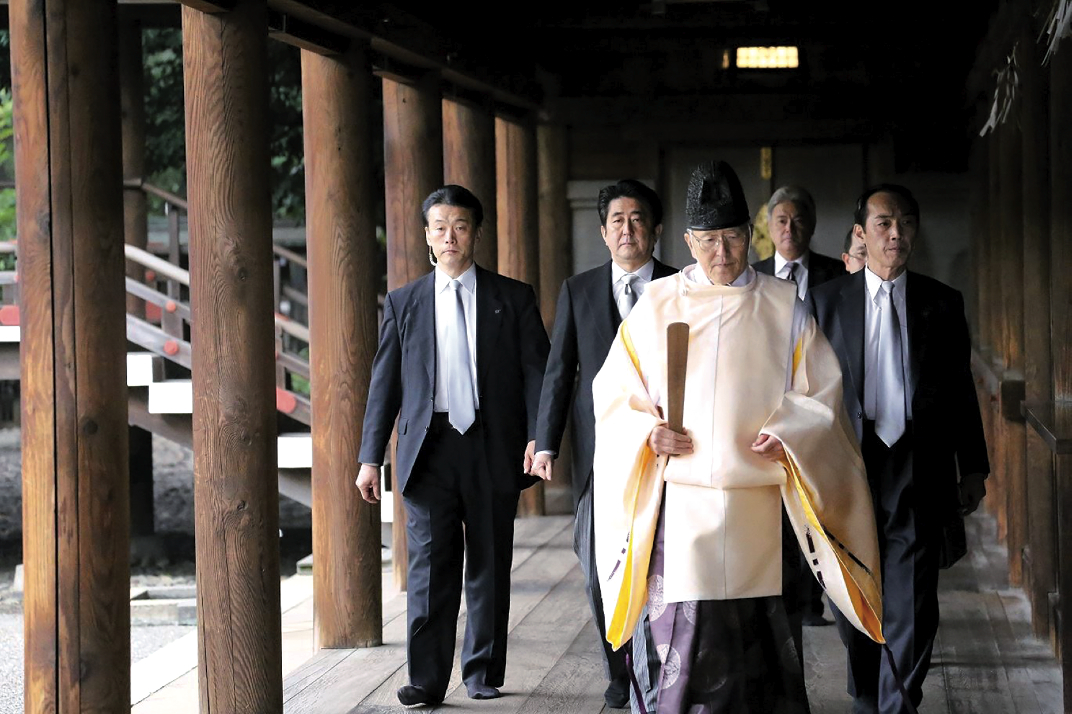
![No51 [MEMORY] A writer who cannot forget](https://www.zoomjapan.info/wp/wp-content/uploads/focus02.png)

